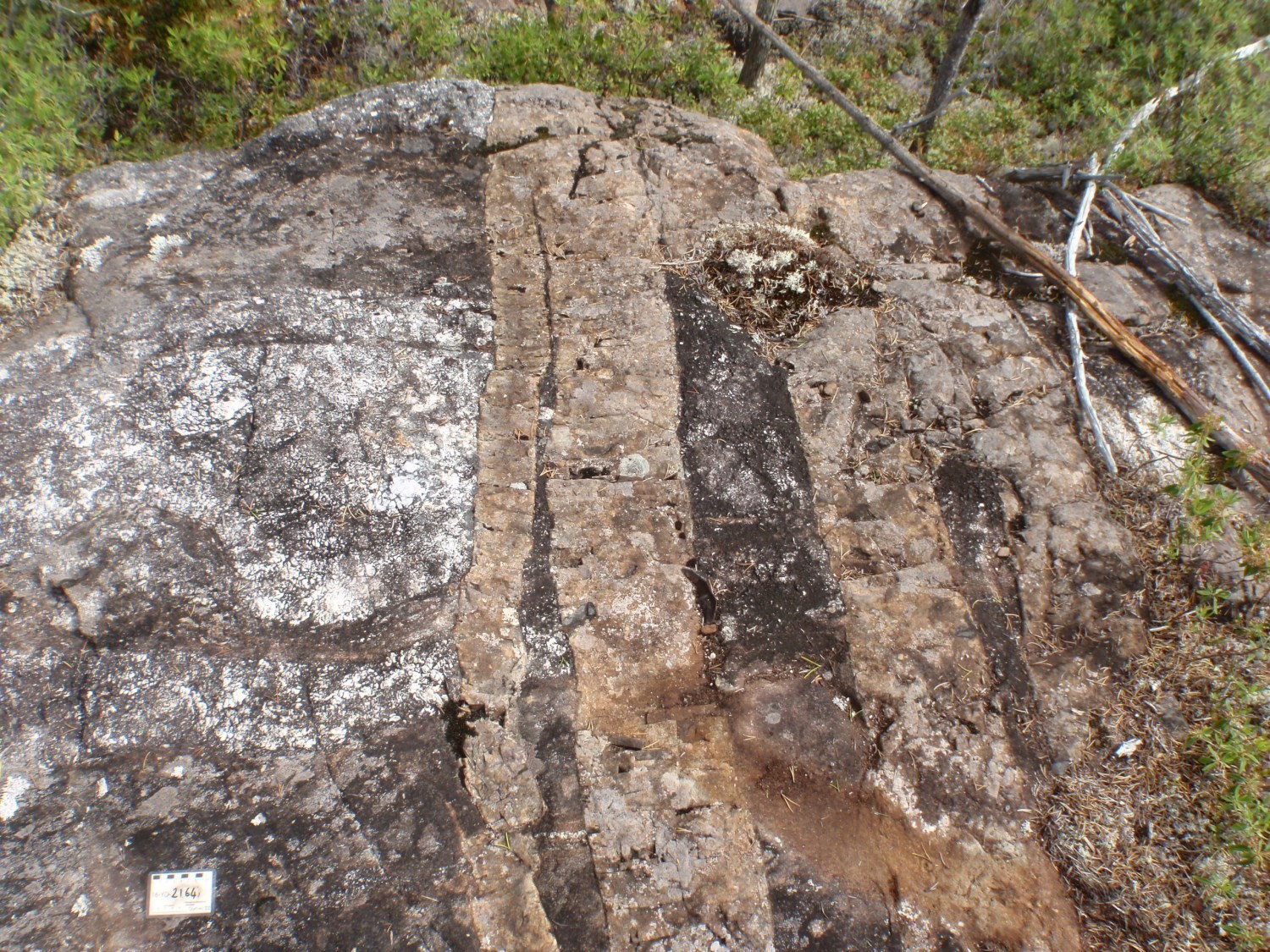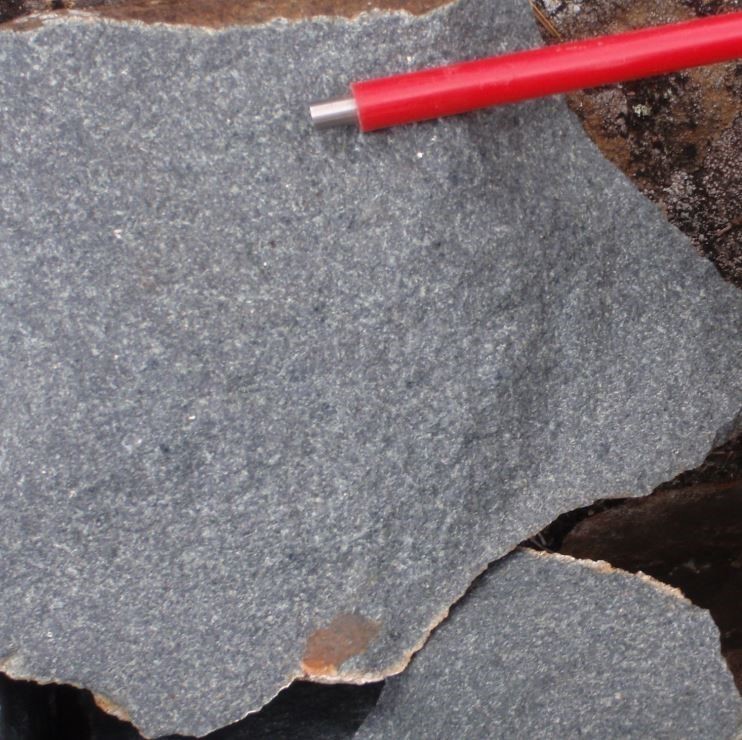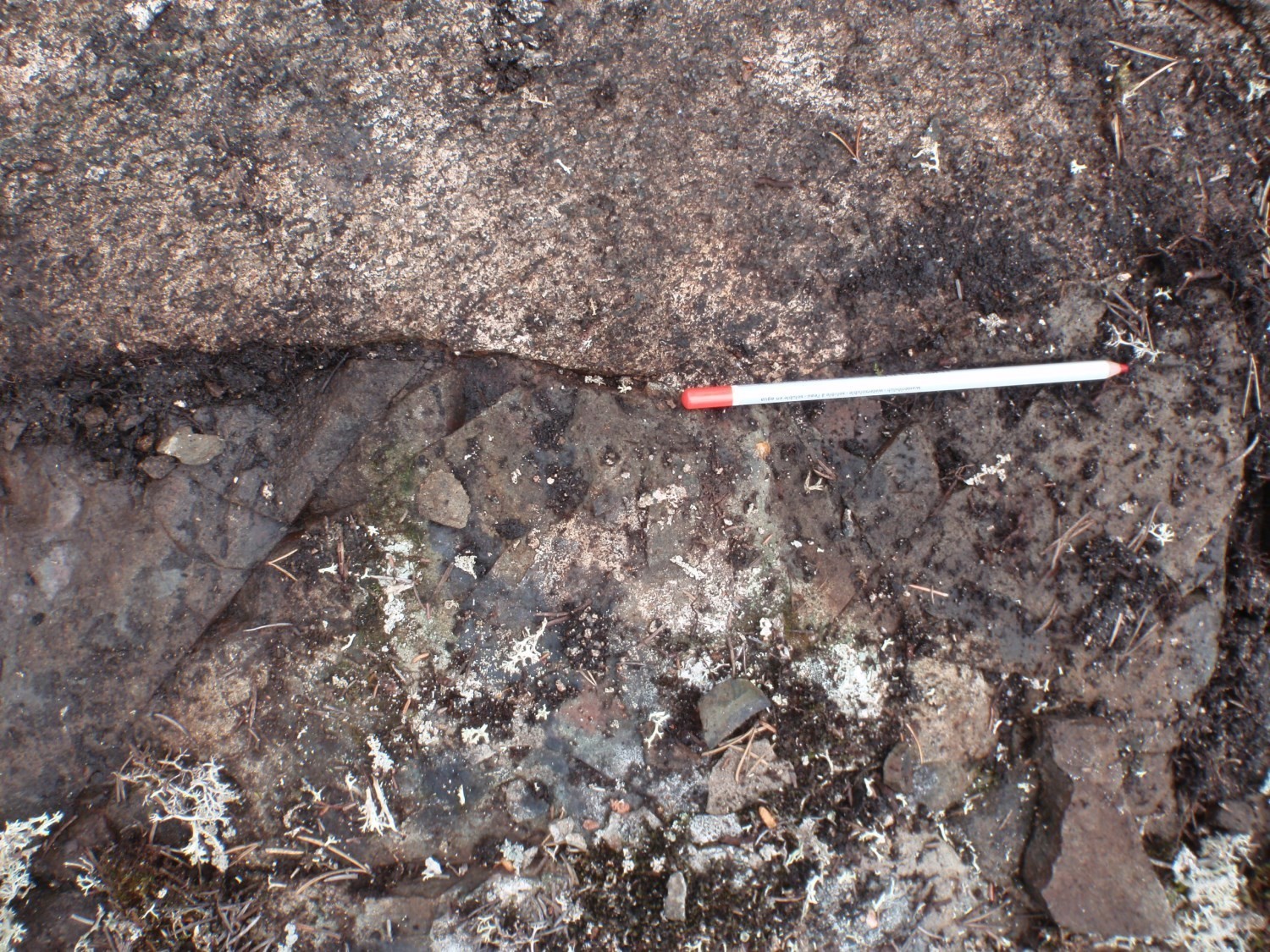
DISCLAIMER: This English version is translated from the original French. In case of any discrepancy, the French version shall prevail.
| Author(s): | Fahrig et al., 1965 |
| Age: | Mesoproterozoic |
| Stratotype: | The Great Abitibi Dyke or the A6 Dyke of Ernst and Buchan (1993) is the reference dyke for the Abitibi Dykes. It is nearly 620 km long, from SW Timmins, Ontario to Chibougamau, Québec. The outcrop on the side of Road 144, south of Timmins, Ontario, is one of the reference outcrops (at coordinates UTM NAD 1983, zone 17 : 456666 m E, 5337026 m N) as this is the U-Pb isotopic dating site. Several geochemistry samples were collected at this site (Ernst and Bell, 1992; Ernst and Buchan, 2010) |
| Type area: | Abitibi-Témiscamingue |
| Geological province: | Superior Province |
| Geological subdivision: | Abitibi, Pontiac, Opatica, Nemiscau and La Grande subprovinces |
| Lithology: | Olivine gabbro |
| Category: | Lithodemic |
| Rank: | Suite |
| Status: | Formal |
| Use: | Active |
None
Background
From the outset of geological mapping in Québec and Ontario, geologists have identified post-Archean dykes and sills of diabase (e.g., Murray et al., 1897). L’Espérance (1948) and Gill and L’Espérance (1952) noted that these dykes, present across the Canadian Shield, were most likely of Keweenawan (Mesoproterozoic) age and could be classified into three categories: 1) undifferentiated or ordinary diabase; 2) quartz diabase; and 3) olivine diabase. Moore (1929) concluded that olivine diabases, to which the Abitibi Dykes belong, were consistently younger than quartz diabases. Isotope datings confirm a Keweenawan age (~1.1 Ga). The name “Abitibi Dykes” was given to these diabases by Fahrig et al. (1965) because they are well exposed on the Ontario shores of Lake Abitibi.
The Fahrig and West (1986) map, based on a compilation and interpretation of aeromagnetic surveys, illustrates the distribution of diabase dyke swarms of the Canadian Shield and their chronologies based on isotopic ages. On this map, the Western Québec ENE dykes are associated with the Abitibi Dykes. Condie et al. (1987) were the first to associate an EW dyke from the James Bay Road Km 295 area with the Abitibi Dykes based on geochemistry.
These dykes are key elements in the study of the Mesoproterozoic palaeomagnetism (the Logan loop). The reference works on these dykes include Fahrig et al. (1965), Condie et al. (1987), Ernst et al. (1987), Ernst and Bell (1992), and Ernst and Buchan (1993).
Some Abitibi dykes were informally individualized by Charbonneau et al. (1991) as part of the Chapais-Branssat geological synthesis (sheets 32G13 and 32G14, southern part of sheet 32J03). They have also been described by Daoudene and Beaudette (2021), namely the Geneviève and Poing dykes.
Beausoleil and Bélanger (2005a and b) and Beausoleil and Goutier (2005a and b) assigned the diabase dykes in the sheet 32D02 to the “Dyke of Preissac” unit. In their extensions in the adjacent sheets, these dykes belong to the Abitibi Dykes and the Matachewan Dyke Swarm. The reassignment is carried out as part of the production of this stratigraphic sheet and the “Dyke of Preissac” unit is abandoned.
Description
The Abitibi Dykes consist of olivine gabbro and are not metamorphosed. Their patina is brown and their fresh surface is greenish. The rock is composed of plagioclase, augite, olivine, titanomagnetite and ilmenite (Ernst and Bell, 1992). Accessory minerals are interstitial and represented by K-feldspar, apatite and biotite. Trace minerals are baddeleyite and zircon. In the presence of very thick dykes (>140 m), there are two units: 1) a margin facies, varying from aphanitic to coarse grained; and 2) a central facies, varying from coarse to very coarse grained (>30 mm), displays a trachytic texture defined by plagioclase phenocrystals. According to the work of Ernst and Bell (1992), the modal composition of the second unit is a monzodiorite with more orthoclase and lower amount of calcic plagioclase (<An50). These dykes are distinguished from other Proterozoic gabbro dykes in the Abitibi Subprovince by a slightly alkaline signature, high levels of K2O, TiO2, P2O5 and Ba, and light rare earth elements enrichment (Ernst et al., 1987; Ernst and Bell, 1992).
In Québec, the hill east of the Anorthosite Lake (sheet 32F11) contains outcrops representative of this dyke. It ranges in thickness from 90 to 137 m. Its patina is brown and fresh surface greenish. It is medium-grained and the subophitic texture is visible in outcrop. The gabbro is composed of partially saussuritized plagioclase, fresh augite, magnetite and locally serpentinized olivine (Goutier, 2005). Accessory minerals are biotite, apatite and orthose. Alteration minerals are chlorite, serpentine, talc and epidote. The dykes at Km 295 of the James Bay Road are also associated with the Abitibi Dykes, although their orientation is almost EW. They have similar pertography and geochemistry (see sample EQ02-01-07 of Ernst and Buchan [2010] and geochemical analysis 2016067346).
Some dykes in the Chapais area were informally named by Charbonneau et al. (1991) and are described below.
The Geneviève Dyke
The Geneviève Dyke is NE-SW trending and ~57 km long. It cuts almost entirely through sheet 32G13 and the NW end of sheet 32G14.
According to Charbonneau et al. (1991), the dyke is composed of an olivine diabase (Hébert, 1983) or olivine dolerite (according to Picard, 1985). These authors described the petrography (pages 124 and 29 respectively). The contacts of the dyke with the host rock are subvertical, sharp and characterized by a 10 cm thick chilled margin. Locally, where apophyses or ramifications (Hébert, 1983) have invaded the adjacent rocks, the contact is less sharp. Hébert (1983) also observed numerous conglomerate and granite xenoliths in the intrusive rock. Locally also, the Geneviève Dyke contains, near its southeastern edge, lenses of massive pentlandite and pyrrhotite with some chalcopyrite and pyrite (see Hébert, 1983, pages 128-129). »
Daoudene and Beaudette (2021) describe the internal phase of the Geneviève Dyke as a coarse-grained, porphyritic olivine gabbro. The rock has an orange-grey alteration patina and a grey fresh surface. The rock has xenomorphic clinopyroxene phenocrysts measuring 0.5 to 1 cm. The dyke is particularly well exposed at outcrop 2021-MB-3027, where three phases are described: the first is coarse grained and contains sulphides, the second is fine grained with feldspar phenocrysts, and the third is very fine grained. The contact between the phases is diffuse. Geochemistry shows that the Geneviève Dyke has a tholeiitic to transitional magmatic affinity (Daoudene and Beaudette, 2021).
In thin section, the olivine gabbro displays a subophitic texture. Plagioclase composes 35% to 60% of the rock. It forms small automorphic crystals, more or less connected, embedded in large pœcilitic crystals of clinopyroxene. The latter represents 25 to 60% of the total rock and, in places, is strongly hematized. The proportion of olivine is distributed between 3 and 20% and it forms clusters of small grains homogeneously disseminated in the rock. The olivine is generally quite fresh, but in places it appears variably altered to serpentine. Opaque minerals account for up to 7% of the rock, while biotite is present in trace amounts. In reflected light, the rocks of outcrop 2021-MB-3027 exhibit, among the opaque minerals, pyrrhotite grains with flares of pentlandite. Around these xenomorphic grains, pyrite and chalcopyrite coronas are observed.
The Poing Dyke
This dyke was initially described by Gilbert (1955) as a coarse-grained, magnetite-rich, olivine diabase. In thin section, MacIntosh (1977) found 30% clinopyroxene locally altered to biotite, 50% saussuritized labradorite, 20% olivine and 5-10% opaque minerals.
According to Daoudene and Beaudette (2021), the geochemical signature of this dyke reveals an alkaline gabbro or syeno-gabbro composition of calc-alkaline magmatic affinity. In outcrop, the rock has an orange-beige alteration patina and a grey fresh surface. The gabbro is medium to coarse grained, subophitic, massive and homogeneous. It is composed of 10 to 20% olivine, 15% clinopyroxene and 50 to 70% plagioclase. The plagioclase forms connected laths embedded in large poikilitic grains of clinopyroxene. Locally, the interstitial spaces between the plagioclase phenocrysts are filled with clusters of olivine grains. Accessory minerals are biotite (2-3%), apatite (1-2%) and opaque minerals (3-10%).
Thickness and Distribution
The Abitibi diabase Dykes are plotted from the magnetic field vertical gradient map in addition to the outcrop observations. They have a straight-lined signature over kilometres and are oriented ENE. Present mainly in the Abitibi Subprovince, they also affect the Pontiac, Opatica, Nemiscau and La Grande subprovinces.
The Great Abitibi Dyke is one of the longest dykes in the world. It extends from northern Sultan in Ontario to northern Chibougamau in Québec, a distance of nearly 620 km. These dykes are almost vertical. The contact with the host rocks is sharp. They range in thickness from a few metres to 250 m (Ernst and Bell, 1992).
Ernst and Buchan (1993) identified eight main dykes (A1 to A8) belonging to the Abitibi Dykes; these are spread over 240,000 km2 from Sault-Sainte-Marie to Chibougamau. A limited number of EW orientation dykes have been identified in the area west of Nemiscau near Km 295 of the James Bay Road (Bandyayera and Daoudene, 2017). The latter were also associated with the Abitibi Dykes based on geochemistry. On the same basis, the dyke A8 and several NE dykes in the region between Malartic Lake and Lebel-sur-Quévillon should not be associated with the Abitibi Dykes since their geochemistry is different (TiO2, K2O, P2O5 contents and La/Yb ratios too low).
Dating
The principal dyke of the Abitibi Dykes, the Great Abitibi Dyke, was dated 1140.6 ±2 Ma by Krogh et al. (1987) from baddeleyites. Previously, K/Ar datings on the A1, A3, A5, A6 and A7 dykes yielded similar ages, between 1220 Ma and 1035 Ma (see Table 1 of Ernst and Buchan, 1993).
| Isotopic System | Mineral | Crystallization Age (Ma) | (+) | (-) | Reference(s) |
| U-Pb | Baddeleyite | 1140.6 | 2 | 2 | Krogh et al., 1987 |
Stratigraphic Relationship(s)
The Abitibi Dykes are among the youngest rocks in Abitibi. Hence, they cut all Archean rocks and all Proterozoic dykes older than 1,100 Ma.
Paleontology
Does not apply.
References
Publications Available through SIGÉOM Examine
BEAUSOLEIL, C., BÉLANGER, M., 2005a. Compilation géoscientifique – Géologie 1/20 000, 32D02-200-0101 – BAIE CARON. In : MRNF, 2010. CARTE(S) GÉOLOGIQUE(S) DU SIGEOM – feuillet 32D. CG SIGEOM32D, 56 plans.
BEAUSOLEIL, C., BÉLANGER, M., 2005b. Compilation géoscientifique – Géologie 1/20 000, 32D02-200-0102 – LAC VAUDRAY. In : MRNF, 2010. CARTE(S) GÉOLOGIQUE(S) DU SIGEOM – feuillet 32D. CG SIGEOM32D, 56 plans.
BEAUSOLEIL, C., GOUTIER, J., 2005c. Compilation géoscientifique – Géologie 1/20 000, 32D02-200-0201 – MCWATTERS. In : MRNF, 2010. CARTE(S) GÉOLOGIQUE(S) DU SIGEOM – feuillet 32D. CG SIGEOM32D, 56 plans.
BEAUSOLEIL, C., GOUTIER, J., 2005d. Compilation géoscientifique – Géologie 1/20 000, 32D02-200-0202 – LAC JOANNÈS. In : MRNF, 2010. CARTE(S) GÉOLOGIQUE(S) DU SIGEOM – feuillet 32D. CG SIGEOM32D, 56 plans.
BANDYAYERA, D., DAOUDENE, Y., 2017. Géologie de la région du lac Rodayer (SNRC 32K13-32K14-32N03 et 32N04-SE). MERN; RG 2017-01, 60 pages, 2 plans.
CHARBONNEAU, J. M., PICARD, C., DUPUIS-HEBERT, L., 1991. Synthèse géologique de la région de Chapais-Branssat (Abitibi). MRN; MM 88-01, 202 pages, 13 plans.
DAOUDENE, Y., BEAUDETTE, M., 2021. Géologie de la région du lac La Trêve, Sous-province d’Abitibi, Eeyou Istchee Baie-James, Québec, Canada. MERN; BG 2022-04, 1 plan.
GILBERT, J. E., 1955. Région de Branssat – Daine, Comté d’Abitibi-Est. MRN; RG 064, 61 pages, 1 plan.
GOUTIER, J., 2005. GEOLOGIE DE LA REGION DE BAIE RAMSAY (32F/10) ET DE LA RIVIERE OPAOCA (32F11). MRNF; RG 2005-01, 58 pages, 8 plans.
HÉBERT, Y., 1983 Géologie de la région du lac La Trêve. IN Rapports d’étape des travaux en cours à la division du Précambien. Ministère de l’Energie et des Ressources, Québec; ET 82-01, 269 pages, 2 plans.
MACINTOSH, J. A., 1977. Geology of the Lantagnac – La Touche area (Abitibi-Est County and Abitibi Territory). MRN; DPV 497, 131 pages, 1 plan.
PICARD, C., 1985. Géologie de la région du lac Inconnu, Abitibi-Est, Québec. MRN; ET 83-16, 55 pages, 2 plans.
Other Publications
CONDIE, K.C., BOBROW, D.J., CARD, K.D., 1987. Geochemistry of Precambrian mafic dykes from the southern Superior Province of the Canadian Shield. In Mafic dyke swarms. Edited by H.C. Halls and W.F. Fahrig. Geological Association of Canada, Special Paper 34, pages 95-108.
ERNST, R.E., BELL, K., 1992. The petrology of the Great Abitibi Dyke, Superior Province, Canada: Journal of Petrology, volume 33, pages 423-469. doi.org/10.1093/petrology/33.2.423
ERNST, R.E., BELL, K., RANALLI, G., HALLS, H.C., 1987. The Great Abitibi Dyke, Southeastern Superior Province, Canada. In Mafic dyke swarms. Edited by H.C. Halls and W.F. Fahrig. Geological Association of Canada, Special Paper 34, pages 123-135.
ERNST, R.E., BUCHAN, K.L., 1993. Paleomagnetism of the Abitibi dyke swarm, southern Superior Province, and implications for the Logan Loop. Canadian Journal of Earth Sciences, volume 30, pages 1886-1897. doi.org/10.1139/e93-167
ERNST, R.E., BUCHAN, K.L., 2010. Geochemical database of Proterozoic intraplate mafic magmatism in Canada. Geological Survey of Canada, Open File 6016, 1 CD-ROM. doi.org/10.4095/261831
FAHRIG, W.F., GAUCHER, E.H., LAROCHELLE, A., 1965. Paleomagnetism of diabase dikes of the Canadian Shield. Canadian Journal of Earth Sciences, volume 2, pages 278-298. doi.org/10.1139/e65-023
FAHRIG, W.F., WEST, T.D., 1986. Diabase dykes swarms of the Canadian Shield – Essaims de dykes diabasiques du Bouclier canadien. Commission géologique du Canada, carte 1627A. doi.org/10.4095/133917
GILL, J.E., L’ESPÉRANCE, R., 1952. Diabase Dykes in the Canadian Shield. Transactions of the Royal Society of Canada, volume XLVI, series III, section four, pages 25-36.
KROGH, T.E., CORFU, F., DAVIS, D.W., DUNNING, G.R., HEAMAN, L.M., KAMO, S.L., MACHADO, N., GREENOUGH, J.D., NAKAMURA, E., 1987. Precise U-Pb isotopic ages of diabase dykes and mafic to ultramafic rocks using trace amounts of baddeleyite and zircon. In Mafic dyke swarms. Edited by H.C. Halls and W.F. Fahrig. Geological Association of Canada, Special Paper 34, pages 147-152.
L’ESPÉRANCE, R.L., 1948. A study of the diabase dykes of the Canadian Shield. Master thesis, McGill university, Montréal, Canada, 48 pages, 1 carte, TH 0306
MOORE, E.S., 1929. Keweenawan Olivine Diabase of the Canadian Shield. Transactions of the Royal Society of Canada; section IV, pages 39-45.
MURRAY, A., BELL, R., BARLOW, A.E., 1897. Province of Ontario, Nipissing, Algoma and Parry Sound districts, French River sheet. Commission géologique du Canada, carte géologique polychrome 570, 1 feuille. doi.org/10.4095/107355
Suggested Citation
Ministère de l’Énergie et des Ressources naturelles (MERN). Abitibi Dykes. Quebec Stratigraphic Lexicon. https://gq.mines.gouv.qc.ca/lexique-stratigraphique/province-du-superieur/dykes-de-abitibi_en [accessed on Day Month Year].
Contributors
|
First Publication |
Jean Goutier, P. Geo., M.Sc. (redaction) Mehdi A. Guemache, P. Geo., Ph.D. (coordination); Claude Dion, Eng., M.Sc. (critical review); Simon Auclair, P. Geo., M.Sc. (editing); Céline Dupuis, P. Geo., Ph.D. (English version); André Tremblay and Nathalie Bouchard (HTML editing). |
|
Revision(s) |
Mélanie Beaudette, P. Geo., M.Sc. melanie.beaudette@mern.gouv.qc.ca; Yannick Daoudene, P. Geo., Ph.D. yannick.daoudene@mern.gouv.qc.ca (redaction) Mehdi A. Guemache, P. Geo., Ph.D. (coordination); James Moorhead, P. Geo., M.Sc. (critical review); Simon Auclair, P. Geo., M.Sc. (editing); Dominique Richard, GIT, Ph.D. (English version); André Tremblay (HTML editing). |



